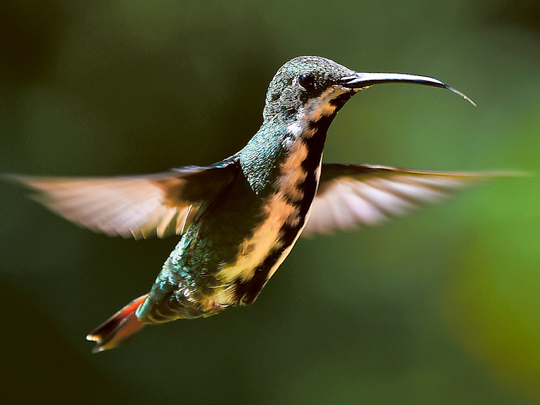
Hummingbirds don’t have teeth, and yet they have quite a sweet tooth. They eat insects to get such essentials as protein and fat, but most of their diet consists of sugary nectar.
This has puzzled scientists. Humans and other animals who prefer sweet tastes are able to recognise them thanks to a pair of sensory receptors known as TIR2 and TIR3. But birds don’t have the gene that codes for TIR2. How, then, do hummingbirds know that nectar and sugar water are sweet?
Now, an international team of biologists and their colleagues think they have found the answer: Over millions of years, genetic mutations converted a receptor that used to help hummingbird ancestors detect the savoury umami taste into a receptor tuned to sweets. A report on their discovery appears in Friday’s edition of the journal ‘Science’.
The team conducted a series of experiments involving the gene for TIR3 and identified a group of 19 mutations that allowed the taste receptor to recognise sugars. However, there are probably additional mutations — in the TIR3 gene as well as the related TIR1 gene — that help make hummingbirds sensitive to sweet tastes, the study authors wrote.
And sensitive they are! In field tests conducted in the Santa Monica Mountains and at other feeding stations, hummingbirds required as few as three quick licks to determine that a feeder contained plain water instead of a sweet solution. They didn’t seem pleased: After tasting the water, they “often displayed a characteristic behavioural pattern involving beak withdrawal, head shaking, and/or spitting,” the researchers reported. This is how hummingbirds react when they taste something bitter, the scientists added.
The birds that visited the feeding stations seemed happy to drink sweet liquids, including ones made with regular sugar, pure glucose and pure fructose. They also eagerly drank solutions with the sugar alcohols sorbitol and erythritol, but they spat out liquids containing the artificial sweeteners sucralose (Splenda), aspertame (NutraSweet), acesulfame potassium (Sunett and Sweet One) and cyclamate.
Scientists have long recognised that some animals have dumped a taste receptor or two along the way. Cats and other creatures that get all their nutrients from meat have lost the TIR2 receptor. Giant pandas, who rely on bamboo for nearly all of their diet, lost TIR1. And sea-dwelling mammals like dolphins and whales no longer have any functional TIR receptors, according to a Perspective that accompanies the study.
Some reptiles alive today do have TIR2. That fact prompted the study authors to hypothesise that the change that erased it in birds occurred in their ancestors, the dinosaurs. The mutations that transformed TIR3 into a detector of sweet tastes must have happened over the last 42 million to 72 million years, allowing hummingbirds to evolve into a distinct family of nectar-drinking birds, they wrote.
Genetic mutations
The study shows that a handful of genetic mutations can modify a single receptor and ultimately fuel the creation of hundreds of species, according to Stephen Liberles, the Harvard Medical School biologist who oversaw the study.
“This dramatic change in the evolution of a new behaviour is a really powerful example of how you can explain evolution on a molecular level,” he said in a statement from Harvard.
A similar process probably gave humans and other mammals the ability to taste sweets, the researchers wrote in the study.
Financial support for the study came from the National Science Foundation, the National Institutes of Health and other funders.
— Los Angeles Times News Service












